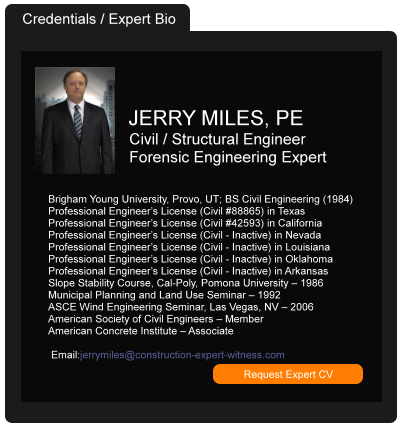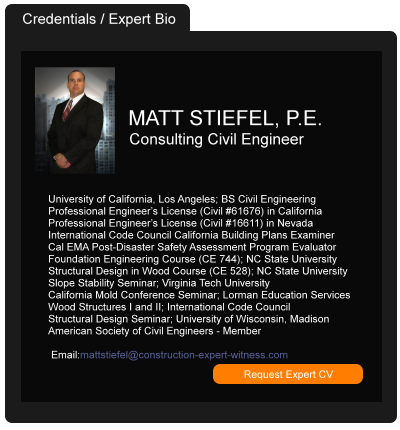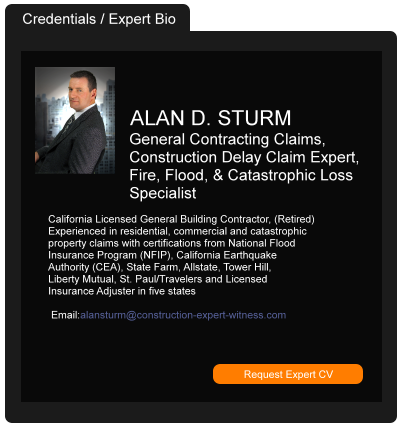Contractor Gets Green Light to Fix Two Fractured Girders at Salesforce Transit Center
January 28, 2019 —
Nadine M. Post - Engineering News-RecordThe Transbay Joint Powers Authority announced Jan. 10 that procurement has begun for the repair of the two fractured bottom flanges of the twin parallel girders that span 80 ft across Fremont Street in the 4.5-block-long Salesforce Transit Center in San Francisco. TJPA shuttered the transit center on Sept. 25, less than six weeks after it had opened, after a ceiling installer noticed a crack in one of the bridgelike spans.
Read the court decisionRead the full story...Reprinted courtesy of
Nadine M. Post, ENRMs. Post may be contacted at
postn@enr.com
Risk-Shifting Tactics for Construction Contracts
February 24, 2020 —
Nate Budde - Construction ExecutiveAnyone who has worked in the construction industry is familiar with the financial risks involved. With thin margins, cash flow issues and the litany of potential claims and damages that can arise, contractors need to be able to manage that risk properly.
There is the right way of going about it, and there's a wrong way. Unfortunately, the wrong way (which involves using leverage and shifting risk to other parties) is the more prevalent approach. There are different contractual tactics employed by owners and general contractors alike to shift financial risk to other parties.
Why is construction so financially risky?
There are a few different reasons there is so much risk involved. First and foremost, the construction payment chain itself is inherently risky. Owners and lenders release project funds and trust that the money will reach everyone on the job. But that can’t happen unless each link in the payment chain passes payment to the next. That's a lot of trust for an industry that's not particularly known for it.
Another reason is how construction projects begin. Upfront payment is rare in this industry. This leads to floating the initial costs, extending credit and potentially borrowing money to do so. And those who typically bear this burden, lower-tier subs and suppliers, are the least equipped for that level of risk.
Reprinted courtesy of
Nate Budde, Construction Executive, a publication of Associated Builders and Contractors. All rights reserved.
Read the court decisionRead the full story...Reprinted courtesy of
Mr. Budde may be contacted at
nate@levelset.com
Do Change Orders Need to be in Writing and Other Things That Might Surprise You
June 02, 2016 —
Garret Murai – California Construction Law BlogYou’ve likely heard it before or maybe you’ve even said it yourself: “Go ahead and get started, we’ll get you a change order later.”
The only thing is, “later” never happens, and after you’ve finished performing the work you find yourself in a fight over whether you’re entitled to get paid for the work you performed.
So, do you need a written change order to get paid for extra work you performed? Read on, you may be surprised.
Read the court decisionRead the full story...Reprinted courtesy of
Garret Murai, Wendel Rosen Black & Dean LLPMr. Murai may be contacted at
gmurai@wendel.com
Too Late for The Blame Game: Massachusetts Court Holds That the Statute of Repose Barred a Product Manufacturer from Seeking Contribution from a Product Installer
March 21, 2022 —
Gus Sara - The Subrogation StrategistIn State Farm Fire & Cas. Co. v. Wangs Alliance Corp., No. 21-cv-10389-AK, 2022 U.S. Dist. LEXIS 26712, the United States District Court for the District of Massachusetts (District Court) considered whether a product manufacturer was barred by the Commonwealth’s six-year statute of repose for improvements to real property from joining the installer of the product as a third-party defendant. The court denied the defendant’s motion for leave to file a third-party complaint to join the installer, finding that the installer completed its work more than six years prior to the motion being filed. This case reminds us that Massachusetts’ six-year statute of repose for improvement to real property also bars a defendant’s contribution claims against third parties.
The Wangs Alliance case involves a subrogation action filed by State Farm Fire & Casualty Insurance (Insurer) against Wangs Alliance Corp. (Wangs), a manufacturer of rope lighting. Insurer insured the homeowners, who experienced a fire in their home in 2018. The home was originally built in 2002 by Wellen Construction (Wellen). As part of the original construction, Wellen installed rope lighting manufactured by Wangs in the house.
Read the court decisionRead the full story...Reprinted courtesy of
Gus Sara, White and WilliamsMr. Sara may be contacted at
sarag@whiteandwilliams.com
Coverage Denied for Ensuing Loss After Foundation Damage
February 07, 2014 —
Tred R. Eyerly – Insurance Law HawaiiThe insureds attempt to secure coverage for ensuing losses after foundation damage was properly denied by the insurer. Walker v. Nationwide Prop. & Cas. Ins. Co., 2014 U.S. Dist. LEXIS 6683 (W.D. Tex. Jan. 6, 2014).
Two provisions excluding coverage under Nationwide's homeowner's policy were key to the court's decision. Exclusion 3 (e) barred coverage for "continuous or repeated seepage or leakage of water or stem over a period of time . . . ." Exclusion 3 (f) (6) precluded coverage for settling, cracking, shrinking, bulging or expansion of pavements, patios, foundations, walls, floors, roof or ceiling.
The policy also included a Dwelling Foundation Endorsement which covered settling, cracking, bulging of floor slabs or footings that supported the dwelling caused by seepage or leakage of water or steam. This endorsement stated the limit of liability would not exceed an amount equal to 15% of the limit of coverage for the dwelling.
Read the court decisionRead the full story...Reprinted courtesy of
Tred R. Eyerly, Insurance Law HawaiiMr. Eyerly may be contacted at
te@hawaiilawyer.com
New World Cup Stadiums Failed at their First Trial
March 12, 2014 —
Beverley BevenFlorez-CDJ STAFFProblems abounded at the inaugural match at one of the new World Cup stadiums in Manaus, Brazil, reported The News Tribune. Problems also were reported at the Arena da Amazonia. Bathrooms weren’t completed, roofs leaked, and some fans were sold tickets for seats that didn’t exist. Furthermore “construction material could be seen in some places and many wheelchair fans had difficulties accessing their seats.”
"This is a critical point that needs to be reevaluated, it can't happen again," said Miguel Capobiango, one of the officials in charge of World Cup preparations in Manaus, as quoted by The News Tribune. "But this is why we have these test events."
Read the court decisionRead the full story...Reprinted courtesy of
Professional Liability Alert: California Appellate Courts In Conflict Regarding Statute of Limitations for Malicious Prosecution Suits Against Attorneys
April 28, 2014 —
David W. Evans & Stephen J. Squillario – Haight Brown & Bonesteel LLPIn conflict with an earlier decision by a different division within the same District, and with a prior decision of another District which followed the earlier case, Division Three of the Second Appellate District has concluded, contrary to established precedent, that the general two-year limitations period set forth in Code of Civil Procedure section 335.1 (“Section 335.1”) applies to malicious prosecution claims against attorneys, rather than the specific one-year statute of limitations for claims against attorneys codified in Code of Civil Procedure section 340.6 (“Section 340.6”).
In Roger Cleveland Golf Co., Inc. v. Krane & Smith, APC (filed April 15, 2014, Case No. B237424, consolidated with Case No. B239375), Roger Cleveland Golf Co., Inc. (“Cleveland Golf”), filed a malicious prosecution action against Krane & Smith (“the Attorneys”), who had unsuccessfully prosecuted the underlying breach of contract matter for their client against Cleveland Golf. In that action, on April 26, 2010, the trial court entered its order granting a motion for nonsuit and dismissing the complaint in favor of Cleveland Golf. On May 24, 2011, or approximately 13 months after the trial court had dismissed the underlying complaint, Cleveland Golf commenced a malicious prosecution action against the Attorneys. In the interim, the Attorneys initiated an appeal of the underlying judgment, which was eventually dismissed approximately seven months later. In response to the complaint, the Attorneys filed a special motion to strike, commonly referred to as an anti-SLAPP motion, which included the argument that the malicious prosecution claim was time-barred under the one-year limitations period of Section 340.6. The trial court granted the Attorneys’ motion based on the statute of limitations (and Cleveland Golf’s failure to demonstrate a probability of success on the merits) and dismissed the case. Cleveland Golf’s appeal followed.
Reprinted courtesy of
David W. Evans, Haight Brown & Bonesteel LLP and
Stephen J. Squillario, Haight Brown & Bonesteel LLP
Mr. Evans may be contacted at devans@hbblaw.com, Mr. Squillario may be contacted at ssquillario@hbblaw.com
Read the court decisionRead the full story...Reprinted courtesy of
April Rise in Construction Spending Not That Much
June 28, 2013 —
CDJ STAFFApril saw an increase in construction spending that didn’t even break a half of a percent with just a 0.4% increase, although that’s better than March’s slight decrease of 0.8%, Both government and residential construction spending dropped, although government spending dropped only 1.2% and residential a miniscule 0.1%. This was slightly more than offset by the modest 2.2% increase in residential spending.
Although the April gains were modest, they come after the first year to increase after five years of decline.
Read the court decisionRead the full story...Reprinted courtesy of


































































